Process Improvement and Six Sigma - Summary of Key Points and Terminology
VerifiedAdded on 2021/10/27
|7
|2054
|449
AI Summary
Read the summary of key points and terminology related to Process Improvement and Six Sigma. Learn about DMAIC, PDSA cycle, SIPOC diagram, and more.
Contribute Materials
Your contribution can guide someone’s learning journey. Share your
documents today.
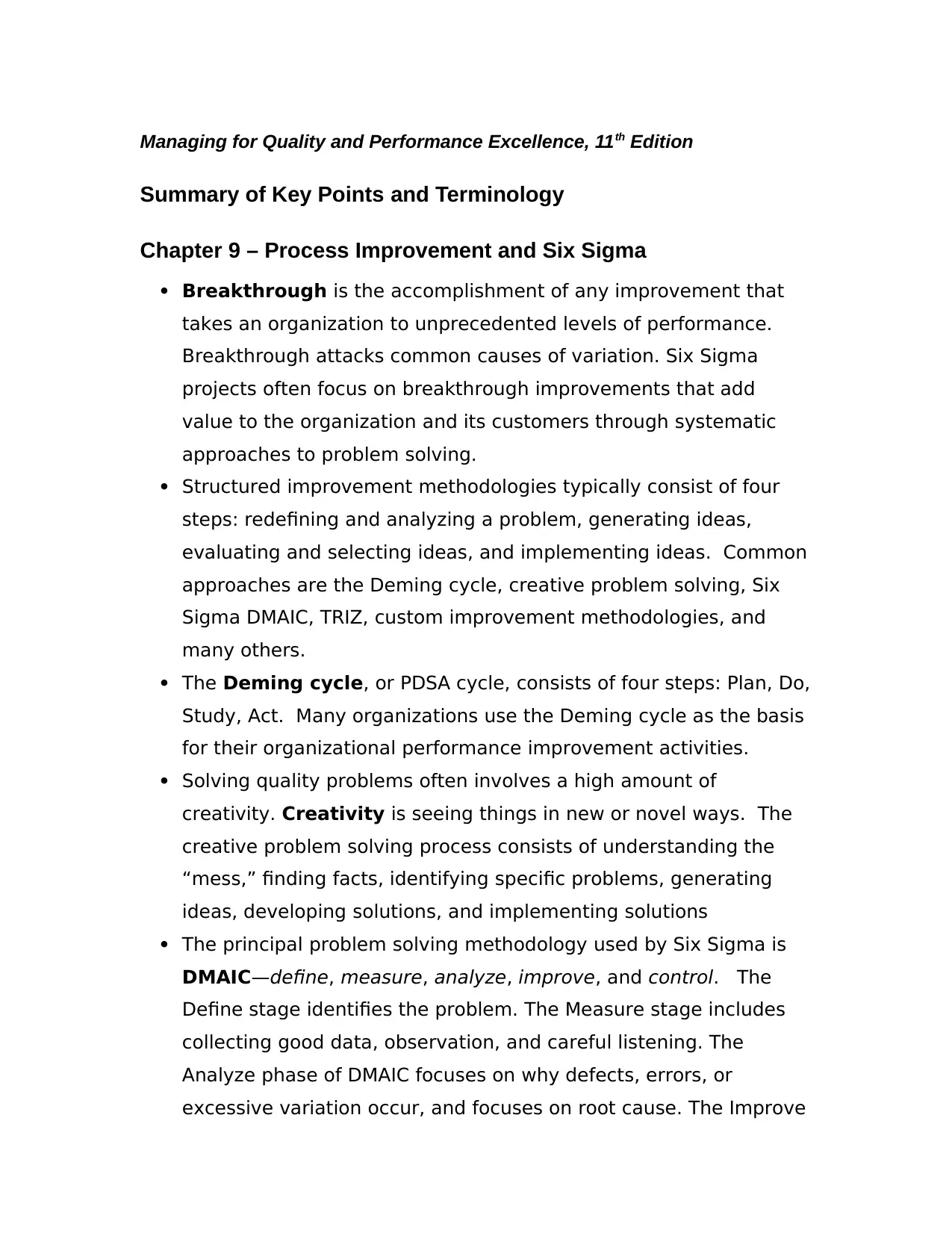
Managing for Quality and Performance Excellence, 11th Edition
Summary of Key Points and Terminology
Chapter 9 – Process Improvement and Six Sigma
Breakthrough is the accomplishment of any improvement that
takes an organization to unprecedented levels of performance.
Breakthrough attacks common causes of variation. Six Sigma
projects often focus on breakthrough improvements that add
value to the organization and its customers through systematic
approaches to problem solving.
Structured improvement methodologies typically consist of four
steps: redefining and analyzing a problem, generating ideas,
evaluating and selecting ideas, and implementing ideas. Common
approaches are the Deming cycle, creative problem solving, Six
Sigma DMAIC, TRIZ, custom improvement methodologies, and
many others.
The Deming cycle, or PDSA cycle, consists of four steps: Plan, Do,
Study, Act. Many organizations use the Deming cycle as the basis
for their organizational performance improvement activities.
Solving quality problems often involves a high amount of
creativity. Creativity is seeing things in new or novel ways. The
creative problem solving process consists of understanding the
“mess,” finding facts, identifying specific problems, generating
ideas, developing solutions, and implementing solutions
The principal problem solving methodology used by Six Sigma is
DMAIC—define, measure, analyze, improve, and control. The
Define stage identifies the problem. The Measure stage includes
collecting good data, observation, and careful listening. The
Analyze phase of DMAIC focuses on why defects, errors, or
excessive variation occur, and focuses on root cause. The Improve
Summary of Key Points and Terminology
Chapter 9 – Process Improvement and Six Sigma
Breakthrough is the accomplishment of any improvement that
takes an organization to unprecedented levels of performance.
Breakthrough attacks common causes of variation. Six Sigma
projects often focus on breakthrough improvements that add
value to the organization and its customers through systematic
approaches to problem solving.
Structured improvement methodologies typically consist of four
steps: redefining and analyzing a problem, generating ideas,
evaluating and selecting ideas, and implementing ideas. Common
approaches are the Deming cycle, creative problem solving, Six
Sigma DMAIC, TRIZ, custom improvement methodologies, and
many others.
The Deming cycle, or PDSA cycle, consists of four steps: Plan, Do,
Study, Act. Many organizations use the Deming cycle as the basis
for their organizational performance improvement activities.
Solving quality problems often involves a high amount of
creativity. Creativity is seeing things in new or novel ways. The
creative problem solving process consists of understanding the
“mess,” finding facts, identifying specific problems, generating
ideas, developing solutions, and implementing solutions
The principal problem solving methodology used by Six Sigma is
DMAIC—define, measure, analyze, improve, and control. The
Define stage identifies the problem. The Measure stage includes
collecting good data, observation, and careful listening. The
Analyze phase of DMAIC focuses on why defects, errors, or
excessive variation occur, and focuses on root cause. The Improve
Secure Best Marks with AI Grader
Need help grading? Try our AI Grader for instant feedback on your assignments.
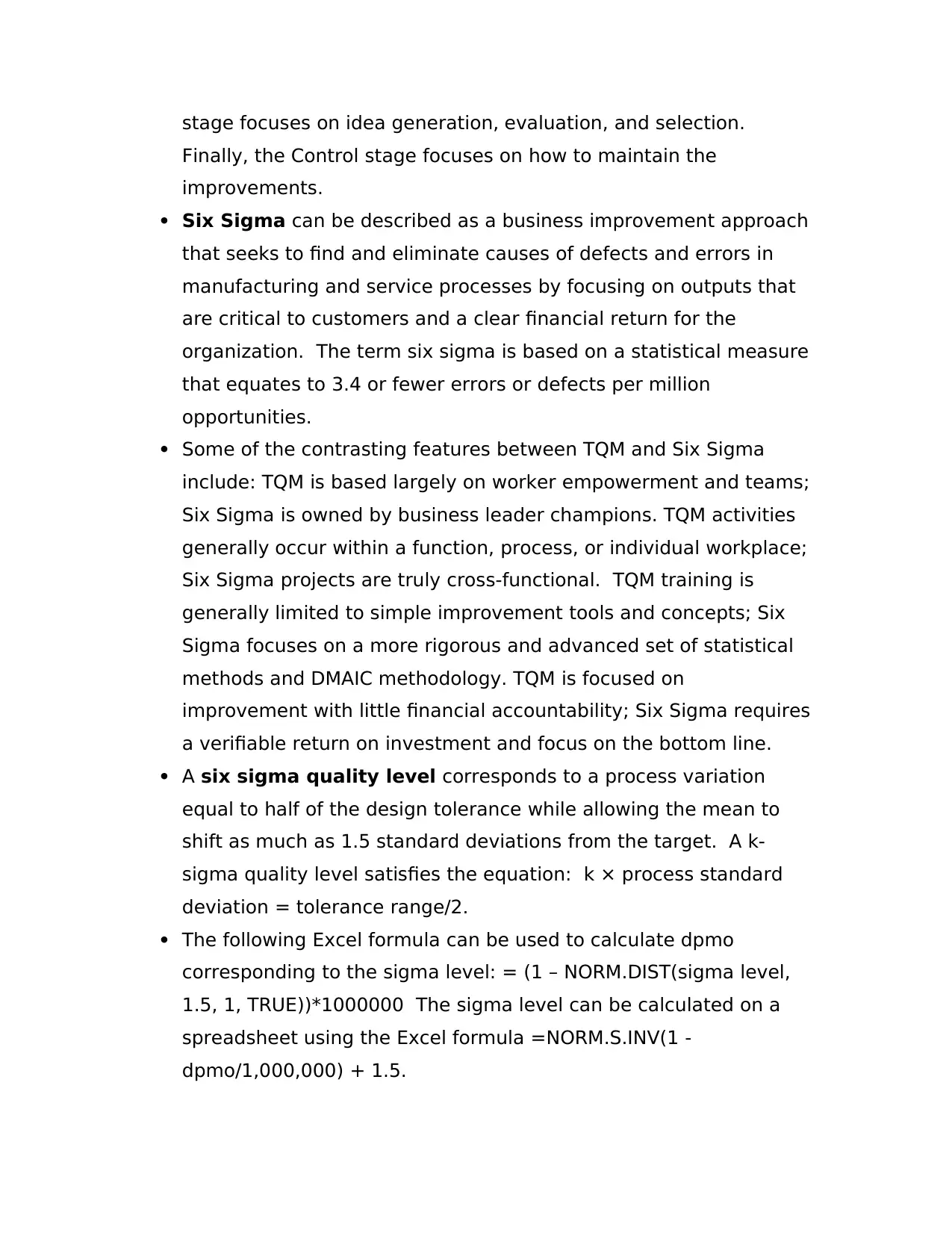
stage focuses on idea generation, evaluation, and selection.
Finally, the Control stage focuses on how to maintain the
improvements.
Six Sigma can be described as a business improvement approach
that seeks to find and eliminate causes of defects and errors in
manufacturing and service processes by focusing on outputs that
are critical to customers and a clear financial return for the
organization. The term six sigma is based on a statistical measure
that equates to 3.4 or fewer errors or defects per million
opportunities.
Some of the contrasting features between TQM and Six Sigma
include: TQM is based largely on worker empowerment and teams;
Six Sigma is owned by business leader champions. TQM activities
generally occur within a function, process, or individual workplace;
Six Sigma projects are truly cross-functional. TQM training is
generally limited to simple improvement tools and concepts; Six
Sigma focuses on a more rigorous and advanced set of statistical
methods and DMAIC methodology. TQM is focused on
improvement with little financial accountability; Six Sigma requires
a verifiable return on investment and focus on the bottom line.
A six sigma quality level corresponds to a process variation
equal to half of the design tolerance while allowing the mean to
shift as much as 1.5 standard deviations from the target. A k-
sigma quality level satisfies the equation: k × process standard
deviation = tolerance range/2.
The following Excel formula can be used to calculate dpmo
corresponding to the sigma level: = (1 – NORM.DIST(sigma level,
1.5, 1, TRUE))*1000000 The sigma level can be calculated on a
spreadsheet using the Excel formula =NORM.S.INV(1 -
dpmo/1,000,000) + 1.5.
Finally, the Control stage focuses on how to maintain the
improvements.
Six Sigma can be described as a business improvement approach
that seeks to find and eliminate causes of defects and errors in
manufacturing and service processes by focusing on outputs that
are critical to customers and a clear financial return for the
organization. The term six sigma is based on a statistical measure
that equates to 3.4 or fewer errors or defects per million
opportunities.
Some of the contrasting features between TQM and Six Sigma
include: TQM is based largely on worker empowerment and teams;
Six Sigma is owned by business leader champions. TQM activities
generally occur within a function, process, or individual workplace;
Six Sigma projects are truly cross-functional. TQM training is
generally limited to simple improvement tools and concepts; Six
Sigma focuses on a more rigorous and advanced set of statistical
methods and DMAIC methodology. TQM is focused on
improvement with little financial accountability; Six Sigma requires
a verifiable return on investment and focus on the bottom line.
A six sigma quality level corresponds to a process variation
equal to half of the design tolerance while allowing the mean to
shift as much as 1.5 standard deviations from the target. A k-
sigma quality level satisfies the equation: k × process standard
deviation = tolerance range/2.
The following Excel formula can be used to calculate dpmo
corresponding to the sigma level: = (1 – NORM.DIST(sigma level,
1.5, 1, TRUE))*1000000 The sigma level can be calculated on a
spreadsheet using the Excel formula =NORM.S.INV(1 -
dpmo/1,000,000) + 1.5.
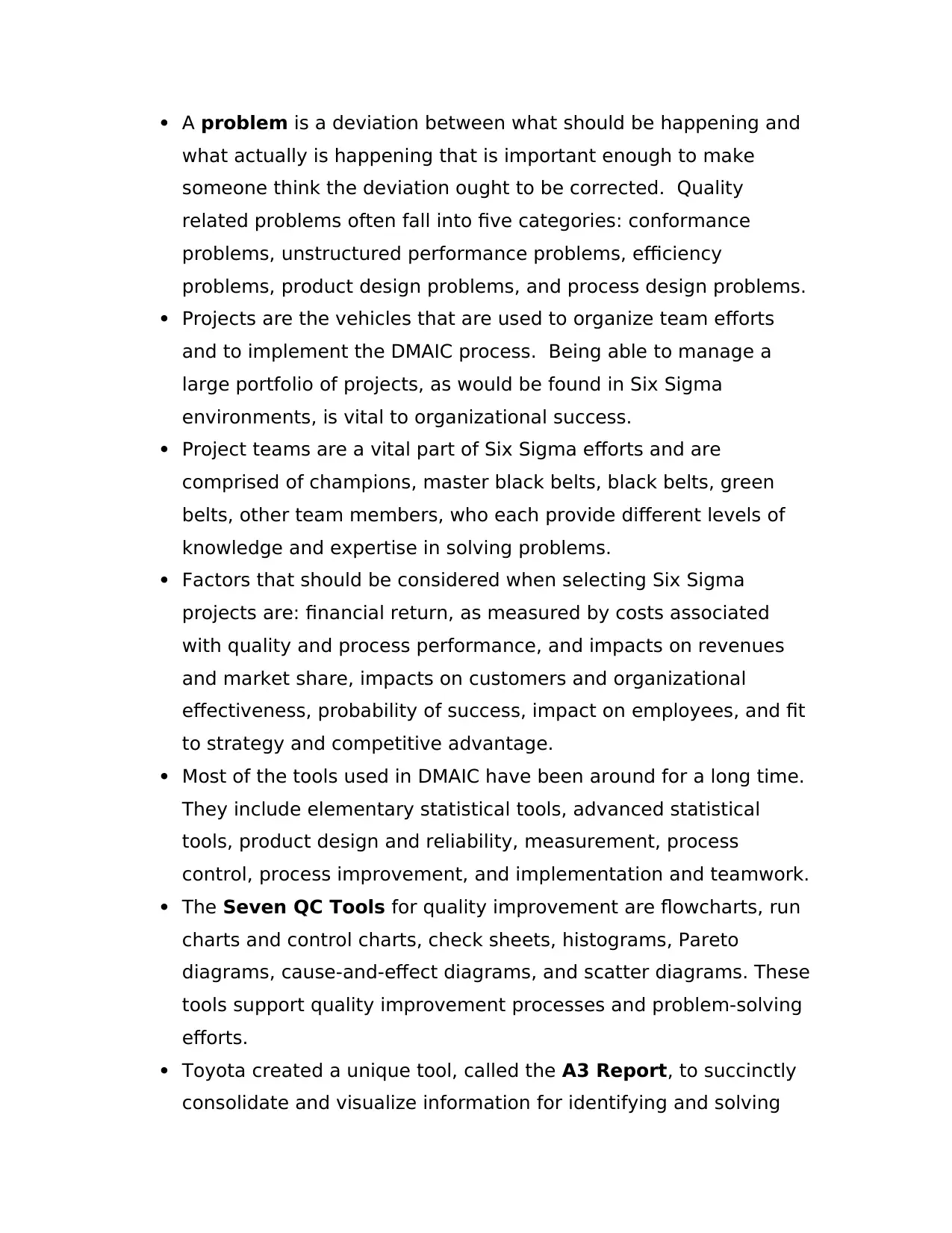
A problem is a deviation between what should be happening and
what actually is happening that is important enough to make
someone think the deviation ought to be corrected. Quality
related problems often fall into five categories: conformance
problems, unstructured performance problems, efficiency
problems, product design problems, and process design problems.
Projects are the vehicles that are used to organize team efforts
and to implement the DMAIC process. Being able to manage a
large portfolio of projects, as would be found in Six Sigma
environments, is vital to organizational success.
Project teams are a vital part of Six Sigma efforts and are
comprised of champions, master black belts, black belts, green
belts, other team members, who each provide different levels of
knowledge and expertise in solving problems.
Factors that should be considered when selecting Six Sigma
projects are: financial return, as measured by costs associated
with quality and process performance, and impacts on revenues
and market share, impacts on customers and organizational
effectiveness, probability of success, impact on employees, and fit
to strategy and competitive advantage.
Most of the tools used in DMAIC have been around for a long time.
They include elementary statistical tools, advanced statistical
tools, product design and reliability, measurement, process
control, process improvement, and implementation and teamwork.
The Seven QC Tools for quality improvement are flowcharts, run
charts and control charts, check sheets, histograms, Pareto
diagrams, cause-and-effect diagrams, and scatter diagrams. These
tools support quality improvement processes and problem-solving
efforts.
Toyota created a unique tool, called the A3 Report, to succinctly
consolidate and visualize information for identifying and solving
what actually is happening that is important enough to make
someone think the deviation ought to be corrected. Quality
related problems often fall into five categories: conformance
problems, unstructured performance problems, efficiency
problems, product design problems, and process design problems.
Projects are the vehicles that are used to organize team efforts
and to implement the DMAIC process. Being able to manage a
large portfolio of projects, as would be found in Six Sigma
environments, is vital to organizational success.
Project teams are a vital part of Six Sigma efforts and are
comprised of champions, master black belts, black belts, green
belts, other team members, who each provide different levels of
knowledge and expertise in solving problems.
Factors that should be considered when selecting Six Sigma
projects are: financial return, as measured by costs associated
with quality and process performance, and impacts on revenues
and market share, impacts on customers and organizational
effectiveness, probability of success, impact on employees, and fit
to strategy and competitive advantage.
Most of the tools used in DMAIC have been around for a long time.
They include elementary statistical tools, advanced statistical
tools, product design and reliability, measurement, process
control, process improvement, and implementation and teamwork.
The Seven QC Tools for quality improvement are flowcharts, run
charts and control charts, check sheets, histograms, Pareto
diagrams, cause-and-effect diagrams, and scatter diagrams. These
tools support quality improvement processes and problem-solving
efforts.
Toyota created a unique tool, called the A3 Report, to succinctly
consolidate and visualize information for identifying and solving

quality problems. They exploit simplicity and visualization to
facilitate process improvement.
The process of drilling down to a more specific problem statement
is sometimes called project scoping.
A Pareto distribution is one in which the characteristics
observed are ordered from largest frequency to smallest. A
Pareto diagram is a histogram of the data from the largest
frequency to the smallest. Pareto diagrams help analysts to
progressively focus in on the most appropriate problems.
One type of high-level process map is called a SIPOC diagram.
SIPOC stands for Suppliers-Inputs-Process-Outputs-Customers.
SIPOC maps provide a broad overview of the key elements in the
process and help to explain who is the process owner, how inputs
are acquired, who the process serves, and how it adds value. In
defining a problem, it is important to have a fundamental
understanding of the process that drives the results.
A project charter defines the project, its objectives, and
deliverables, and represents a contract between the project team
and the sponsor. A project charter will typically define the
problem in a simple fashion, the project objective, the project
team and sponsor, the customers and CTQs (critical to quality
attributes) on which the project focuses, existing measures and
performance benchmarks, expected benefits and financial
justification, a project timeline, and the resources needed to carry
out the project.
In the Measure stage, Six Sigma uses the notion of a function in
mathematics to portray the relationship between process
performance and customer value: Y = f(X), where Y is the set of
CTQs and X represents the set of critical input variables that
influence Y. A CTQ tree structure might be used “drill down” from
Y to identify the critical X-factors. Understanding these
facilitate process improvement.
The process of drilling down to a more specific problem statement
is sometimes called project scoping.
A Pareto distribution is one in which the characteristics
observed are ordered from largest frequency to smallest. A
Pareto diagram is a histogram of the data from the largest
frequency to the smallest. Pareto diagrams help analysts to
progressively focus in on the most appropriate problems.
One type of high-level process map is called a SIPOC diagram.
SIPOC stands for Suppliers-Inputs-Process-Outputs-Customers.
SIPOC maps provide a broad overview of the key elements in the
process and help to explain who is the process owner, how inputs
are acquired, who the process serves, and how it adds value. In
defining a problem, it is important to have a fundamental
understanding of the process that drives the results.
A project charter defines the project, its objectives, and
deliverables, and represents a contract between the project team
and the sponsor. A project charter will typically define the
problem in a simple fashion, the project objective, the project
team and sponsor, the customers and CTQs (critical to quality
attributes) on which the project focuses, existing measures and
performance benchmarks, expected benefits and financial
justification, a project timeline, and the resources needed to carry
out the project.
In the Measure stage, Six Sigma uses the notion of a function in
mathematics to portray the relationship between process
performance and customer value: Y = f(X), where Y is the set of
CTQs and X represents the set of critical input variables that
influence Y. A CTQ tree structure might be used “drill down” from
Y to identify the critical X-factors. Understanding these
Secure Best Marks with AI Grader
Need help grading? Try our AI Grader for instant feedback on your assignments.
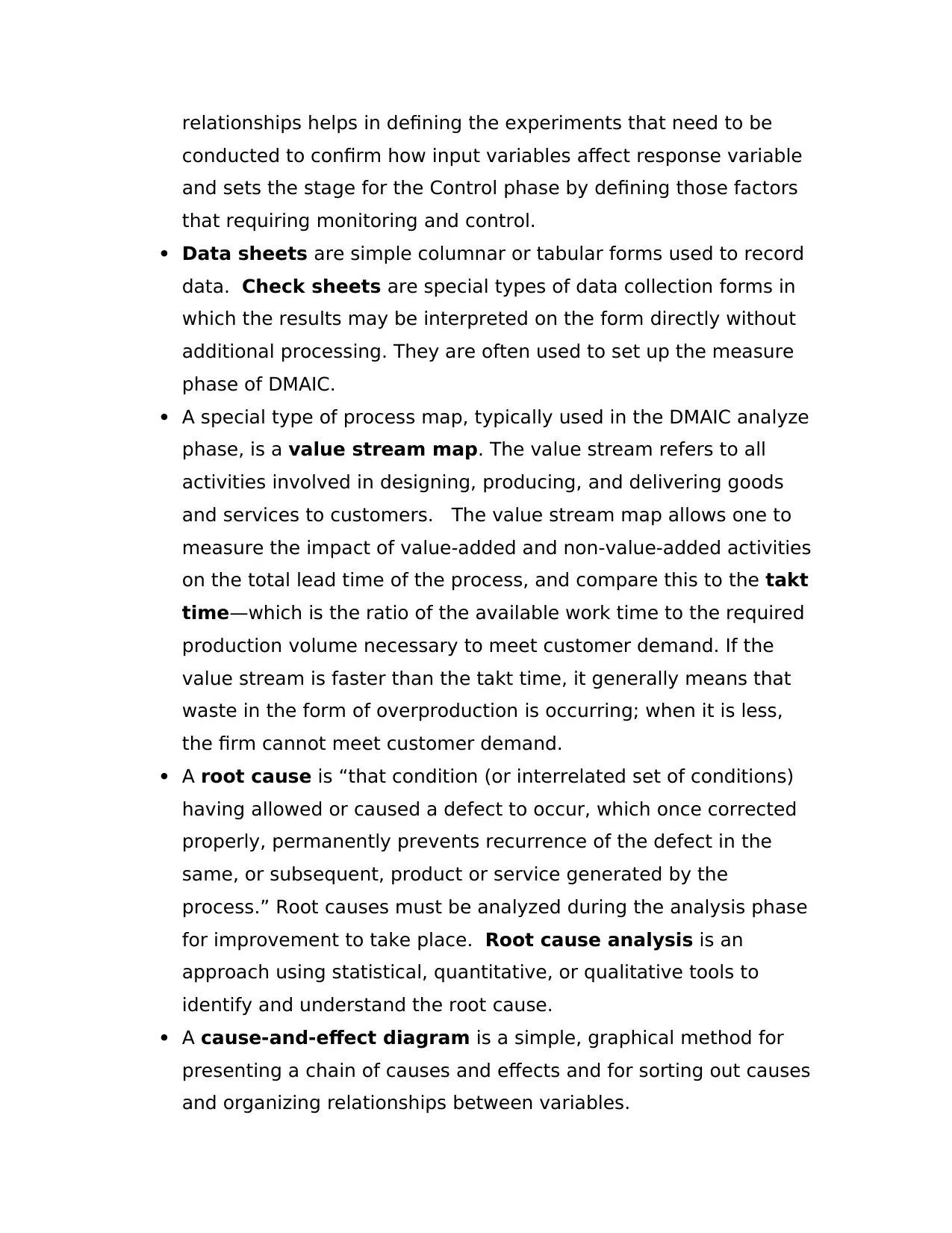
relationships helps in defining the experiments that need to be
conducted to confirm how input variables affect response variable
and sets the stage for the Control phase by defining those factors
that requiring monitoring and control.
Data sheets are simple columnar or tabular forms used to record
data. Check sheets are special types of data collection forms in
which the results may be interpreted on the form directly without
additional processing. They are often used to set up the measure
phase of DMAIC.
A special type of process map, typically used in the DMAIC analyze
phase, is a value stream map. The value stream refers to all
activities involved in designing, producing, and delivering goods
and services to customers. The value stream map allows one to
measure the impact of value-added and non-value-added activities
on the total lead time of the process, and compare this to the takt
time—which is the ratio of the available work time to the required
production volume necessary to meet customer demand. If the
value stream is faster than the takt time, it generally means that
waste in the form of overproduction is occurring; when it is less,
the firm cannot meet customer demand.
A root cause is “that condition (or interrelated set of conditions)
having allowed or caused a defect to occur, which once corrected
properly, permanently prevents recurrence of the defect in the
same, or subsequent, product or service generated by the
process.” Root causes must be analyzed during the analysis phase
for improvement to take place. Root cause analysis is an
approach using statistical, quantitative, or qualitative tools to
identify and understand the root cause.
A cause-and-effect diagram is a simple, graphical method for
presenting a chain of causes and effects and for sorting out causes
and organizing relationships between variables.
conducted to confirm how input variables affect response variable
and sets the stage for the Control phase by defining those factors
that requiring monitoring and control.
Data sheets are simple columnar or tabular forms used to record
data. Check sheets are special types of data collection forms in
which the results may be interpreted on the form directly without
additional processing. They are often used to set up the measure
phase of DMAIC.
A special type of process map, typically used in the DMAIC analyze
phase, is a value stream map. The value stream refers to all
activities involved in designing, producing, and delivering goods
and services to customers. The value stream map allows one to
measure the impact of value-added and non-value-added activities
on the total lead time of the process, and compare this to the takt
time—which is the ratio of the available work time to the required
production volume necessary to meet customer demand. If the
value stream is faster than the takt time, it generally means that
waste in the form of overproduction is occurring; when it is less,
the firm cannot meet customer demand.
A root cause is “that condition (or interrelated set of conditions)
having allowed or caused a defect to occur, which once corrected
properly, permanently prevents recurrence of the defect in the
same, or subsequent, product or service generated by the
process.” Root causes must be analyzed during the analysis phase
for improvement to take place. Root cause analysis is an
approach using statistical, quantitative, or qualitative tools to
identify and understand the root cause.
A cause-and-effect diagram is a simple, graphical method for
presenting a chain of causes and effects and for sorting out causes
and organizing relationships between variables.
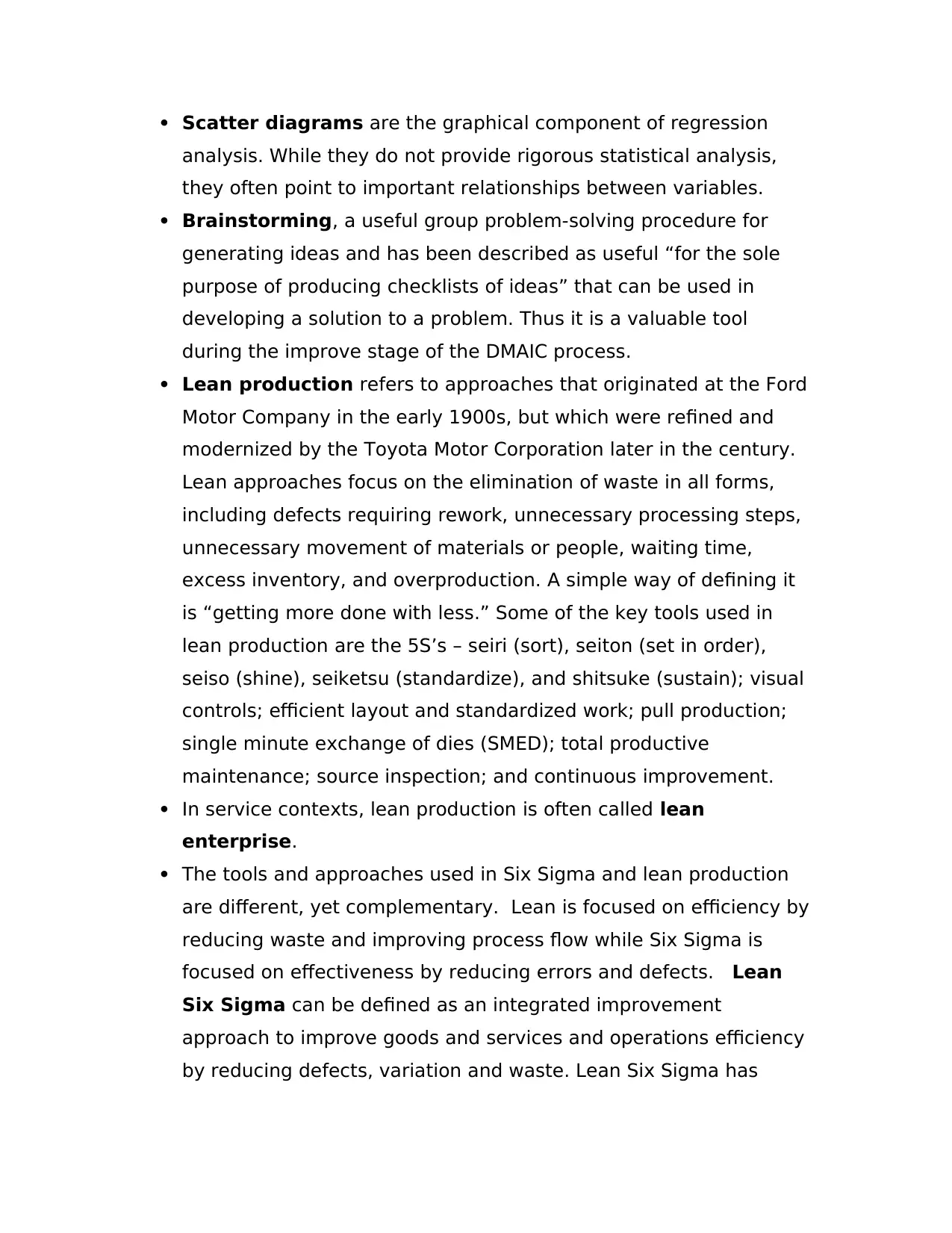
Scatter diagrams are the graphical component of regression
analysis. While they do not provide rigorous statistical analysis,
they often point to important relationships between variables.
Brainstorming, a useful group problem-solving procedure for
generating ideas and has been described as useful “for the sole
purpose of producing checklists of ideas” that can be used in
developing a solution to a problem. Thus it is a valuable tool
during the improve stage of the DMAIC process.
Lean production refers to approaches that originated at the Ford
Motor Company in the early 1900s, but which were refined and
modernized by the Toyota Motor Corporation later in the century.
Lean approaches focus on the elimination of waste in all forms,
including defects requiring rework, unnecessary processing steps,
unnecessary movement of materials or people, waiting time,
excess inventory, and overproduction. A simple way of defining it
is “getting more done with less.” Some of the key tools used in
lean production are the 5S’s – seiri (sort), seiton (set in order),
seiso (shine), seiketsu (standardize), and shitsuke (sustain); visual
controls; efficient layout and standardized work; pull production;
single minute exchange of dies (SMED); total productive
maintenance; source inspection; and continuous improvement.
In service contexts, lean production is often called lean
enterprise.
The tools and approaches used in Six Sigma and lean production
are different, yet complementary. Lean is focused on efficiency by
reducing waste and improving process flow while Six Sigma is
focused on effectiveness by reducing errors and defects. Lean
Six Sigma can be defined as an integrated improvement
approach to improve goods and services and operations efficiency
by reducing defects, variation and waste. Lean Six Sigma has
analysis. While they do not provide rigorous statistical analysis,
they often point to important relationships between variables.
Brainstorming, a useful group problem-solving procedure for
generating ideas and has been described as useful “for the sole
purpose of producing checklists of ideas” that can be used in
developing a solution to a problem. Thus it is a valuable tool
during the improve stage of the DMAIC process.
Lean production refers to approaches that originated at the Ford
Motor Company in the early 1900s, but which were refined and
modernized by the Toyota Motor Corporation later in the century.
Lean approaches focus on the elimination of waste in all forms,
including defects requiring rework, unnecessary processing steps,
unnecessary movement of materials or people, waiting time,
excess inventory, and overproduction. A simple way of defining it
is “getting more done with less.” Some of the key tools used in
lean production are the 5S’s – seiri (sort), seiton (set in order),
seiso (shine), seiketsu (standardize), and shitsuke (sustain); visual
controls; efficient layout and standardized work; pull production;
single minute exchange of dies (SMED); total productive
maintenance; source inspection; and continuous improvement.
In service contexts, lean production is often called lean
enterprise.
The tools and approaches used in Six Sigma and lean production
are different, yet complementary. Lean is focused on efficiency by
reducing waste and improving process flow while Six Sigma is
focused on effectiveness by reducing errors and defects. Lean
Six Sigma can be defined as an integrated improvement
approach to improve goods and services and operations efficiency
by reducing defects, variation and waste. Lean Six Sigma has

gained considerable favor among practitioners in many
organizations.
Although Six Sigma was developed in the manufacturing sector, it
can easily be applied to a wide variety of transactional,
administrative, and service areas. Services are generally driven by
four key measures of performance:
o Accuracy, as measured by correct financial figures,
completeness of information, or freedom from data errors
o Cycle time, which is a measure of how long it takes to do
something, such as pay an invoice
o Cost, that is, the internal cost of process activities (in many
cases, cost is largely determined by the accuracy and/or
cycle time of the process; the longer it takes, and the more
mistakes that have to be fixed, the higher the cost)
o Customer satisfaction, which is typically the primary
measure of success. Therefore, differences between
services and manufacturing make opportunities in services
more difficult to identify, and projects more difficult to
define. Small organizations (including manufacturing and
services) can use Six Sigma, although perhaps in a more
informal fashion.
organizations.
Although Six Sigma was developed in the manufacturing sector, it
can easily be applied to a wide variety of transactional,
administrative, and service areas. Services are generally driven by
four key measures of performance:
o Accuracy, as measured by correct financial figures,
completeness of information, or freedom from data errors
o Cycle time, which is a measure of how long it takes to do
something, such as pay an invoice
o Cost, that is, the internal cost of process activities (in many
cases, cost is largely determined by the accuracy and/or
cycle time of the process; the longer it takes, and the more
mistakes that have to be fixed, the higher the cost)
o Customer satisfaction, which is typically the primary
measure of success. Therefore, differences between
services and manufacturing make opportunities in services
more difficult to identify, and projects more difficult to
define. Small organizations (including manufacturing and
services) can use Six Sigma, although perhaps in a more
informal fashion.
1 out of 7
Related Documents
Your All-in-One AI-Powered Toolkit for Academic Success.
+13062052269
info@desklib.com
Available 24*7 on WhatsApp / Email
![[object Object]](/_next/static/media/star-bottom.7253800d.svg)
Unlock your academic potential
© 2024 | Zucol Services PVT LTD | All rights reserved.





